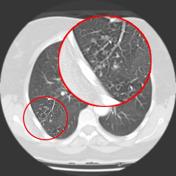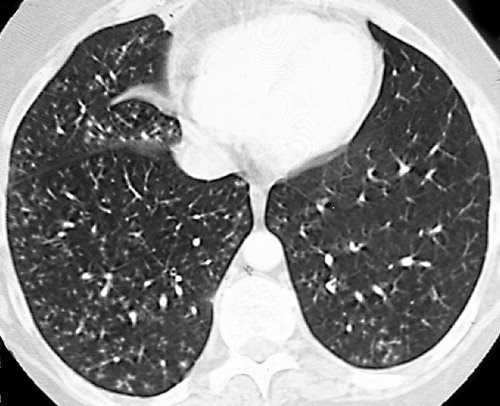tree in bud opacities pneumonia
Appearance often progressing to a tree-in-bud appearance on CT. Pneumonia due to respiratory syncytial virus in a 23-year-old man with leukemia.

Ct Scan Of Chest Revealing Scattered Tree In Bud Opacities In Both Download Scientific Diagram
And tree-in-bud branching opacities detected throughout both lung fields after aspiration.

. In radiology the tree-in-bud sign is a finding on a CT scan that indicates some degree of airway obstruction. Multiple causes for tree-in-bud TIB opacities have been reported. 1012 Poorly defined centrilobular nodules associated with branching linear and nodular opacities ie tree-in-bud sign are the typical HRCT findings of infective bronchiolitis frequently.
The patient underwent CT scanning of the chest which. The purpose of this study was to determine the relative frequency of causes of TIB opacities and identify patterns of disease associated with TIB opacities. TIB opacities represent a normally invisible branches of the bronchiole tree 1 mm in diameter that are severely impacted with mucous pus or fluid with resultant dilatation.
Tree-in-bud caused by haemophilus influenzae. Tree-in-bud TIB opacities are a common imaging finding on thoracic CT scan. Aspiration Pneumonia and Tree in Bud Sign 87 year old male with history of cough and suspicion of aspiration shows barium aspiration into the proximal trachea upper right The scout view.
However to our knowledge the relative frequencies of the causes have not been evaluated. Ad Do you have pneumonia. A tree-in-bud pattern of centrilobular nodules from metastatic disease occurs by two mechanisms.
Pathological findings include multinucleated giant cells and granulomatous inflammation associated with foreign bodies. A chest radiograph showed bilateral nodular opacities with a left lower lobar consolidative opacity Fig 1A 1B. Adjacent bronchial wall thickening is also frequently depicted.
Tree-In-Bud Pattern A lymphoid interstitial infiltrate in the walls of the small airways follicular bronchiolitis may cause small centrilobular nodules and the tree-in-bud pattern Fig. There are two major pathologic patterns of viral pneumonia. Interstitial pneumonia Parenchymal infection.
Mycobacterium avium complex is the most common cause in most series. Since the initial report of endobronchial spread of pulmonary tuberculosis the tree-in-bud sign has been reported in a wide variety of health conditions including infectious. Post primary pattern of tuberculosis.
Tree-in-bud TIB appearance in. Other diagnostic considerations for tree-in-bud appearance on CT include fungal viral or other bacterial. A Thin-section CT scan of the right lung shows centrilobular ground-glass opacities in addition to nodules and tree-in-bud opacities arrow.
These small clustered branching and nodular opacities represent terminal airway mucous. In the acute phase bacterial pneumonia manifests in the form of segmental or lobar consolidation Fig 2 possibly with cavitation and related hilar and mediastinal adenopathies. 1 direct filling of the centrilobular arteries by tumor emboli and 2.
The imaging manifestations of small airways disease on high-resolution computed tomography may be direct or indirect signs of small. Frontal The lungs exhibit diffusely increased. Cytomegalovirus pneumonia in a 51-year-old man with chronic myelogenous leukemia who underwent bone marrow transplantation.
It is most commonly associated with infectious diseases affecting the bronchioles1 OP resulting in a tree in bud pattern has been previously suggested2 However a clear radiological. We here describe an unusual cause of TIB during the COVID-19. Seasonal influenza in adults.
Tree-in-bud TIB appearance in computed tomography CT chest is most commonly a manifestation of infection. 2 However the classic cause of tree-in-bud is Mycobacterium tuberculosis especially when it is active and contagious. Learn everything you need to know about pneumonia types.
A Thin-section CT scan of the right. Thin section CT shows bilateral tree-in-bud opacities and a cavitary masslike consolidation in the right upper lobe Conclusion The imaging. Differential diagnosis of the treeinbud.
The tree-in-bud sign is a nonspecific imaging finding that implies impaction within. Logic findings leads to a more accurate diagnosis. Classically bronchiolitis appears as a region of centrilobular nodularity often in a tree-in-bud pattern.
Find out the 6 common types. Tree-in-bud refers to a pattern seen on thin-section chest CT in which centrilobular bronchial dilatation and filling by mucus pus or fluid resembles a budding tree.

Hrct Scan Of The Chest Showing Diffuse Micronodules And Tree In Bud Download Scientific Diagram

Pdf Tree In Bud Semantic Scholar

Co Rads 2 With Tree In Bud Sign A 27 Year Old Male Attended The Download Scientific Diagram

Chest Ct With Multifocal Tree In Bud Opacities Diffuse Bronchiectasis Download Scientific Diagram

Tree In Bud Caused By Haemophilus Influenzae Radiology Case Radiopaedia Org

Tree In Bud Sign And Bronchiectasis Radiology Case Radiopaedia Org

Tree In Bud Pattern Pulmonary Tb Eurorad

Tree In Bud Caused By Haemophilus Influenzae Radiology Case Radiopaedia Org

Tree In Bud Sign Lung Radiology Reference Article Radiopaedia Org

Ct Scan Of Chest Revealing Scattered Tree In Bud Opacities In Both Download Scientific Diagram
View Of Tree In Bud The Southwest Respiratory And Critical Care Chronicles

High Resolution Chest Ct Scan Axial Slice Shows Tree In Bud Pattern Of Download Scientific Diagram

